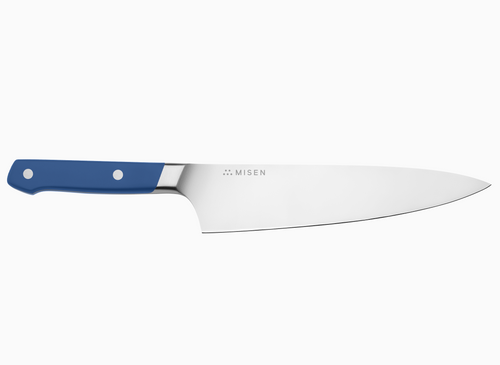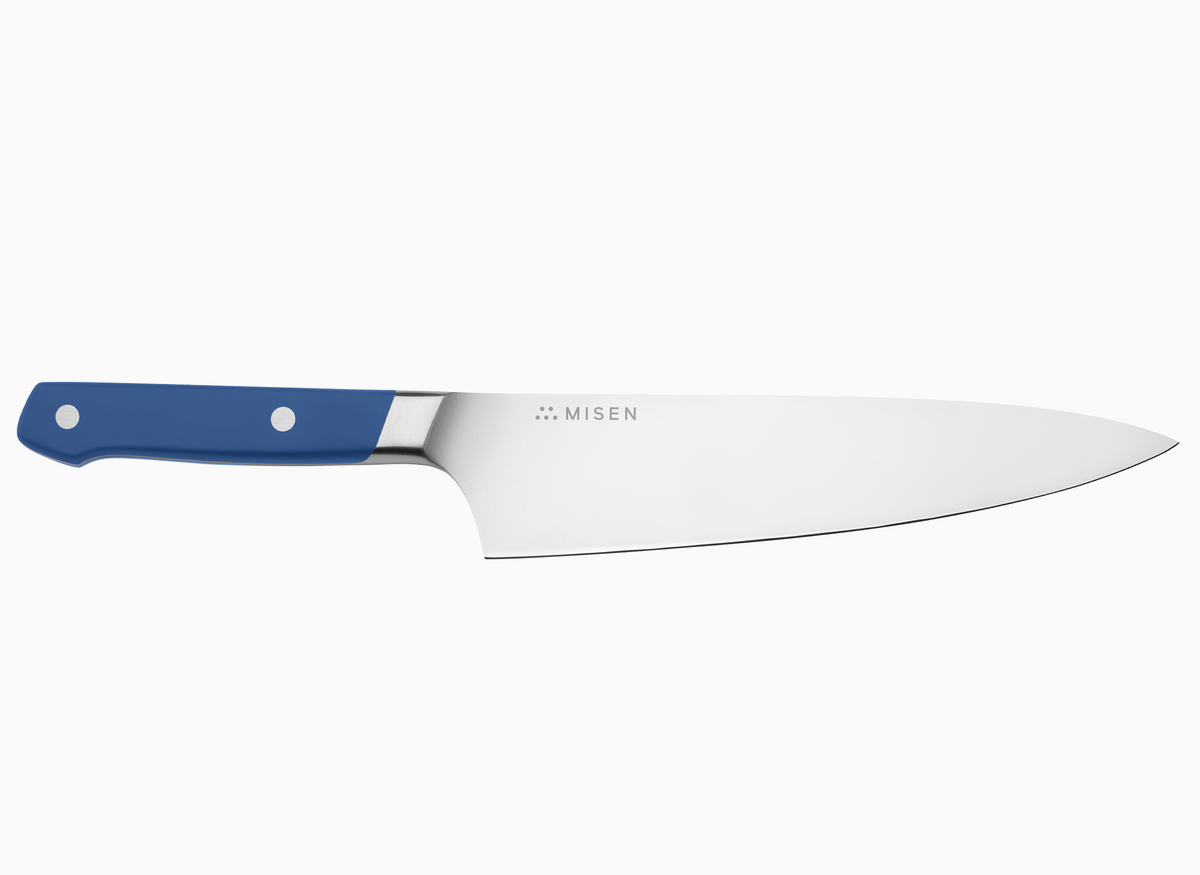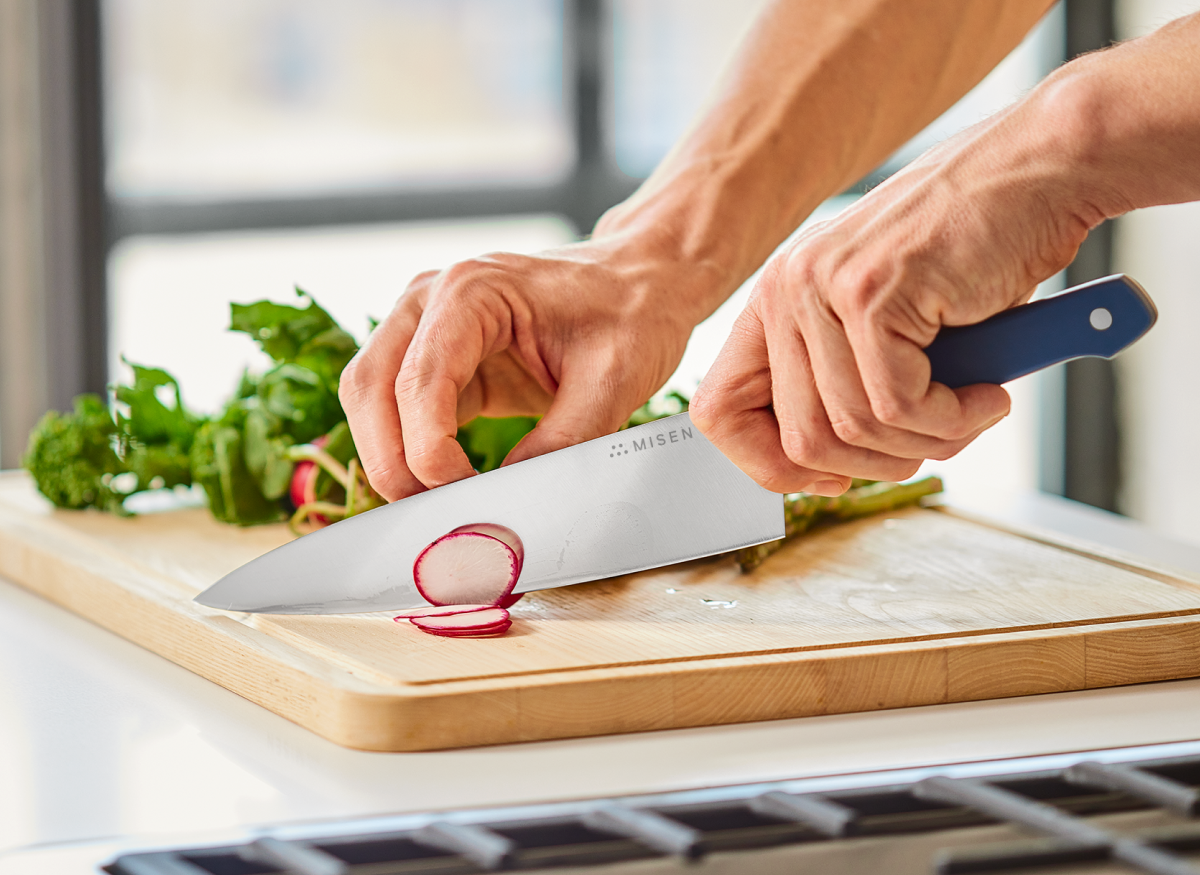The 3 Kitchen Knives Every Home Cook Needs
 There are many kinds of kitchen knives, but most home cooks only need three.
There are many kinds of kitchen knives, but most home cooks only need three.
- Having the right knife for your task leads to a successful kitchen experience.
- A chef’s knife is an all-purpose knife and the first one to add to your arsenal.
- Other knives, like serrated knives and paring knives, provide more specialized functions.
The difference between having the right knife and having the wrong knife is vast. It separates a jagged chop from a clean cut and turns a 10-minute ordeal into a single, swift slice.
The more time you spend in the kitchen, the more you realize just how important it is to have the right knife. But before you add that entire knife block set to your cart, you should know that it’s hard to approach such a specific problem with a prepackaged solution.
Are you an occasional cook or a daily dabbler? Either way, it’s much better to build a cutlery set of your own, one that addresses your needs. While you won't need every knife available to prepare a good meal, you will need a crucial few.
The Knives You Need
Certain knives are suited for certain tasks, and having just the one you need will make your cooking experience easier and more enjoyable. A good collection of kitchen knives will range in length and shape, each one designed to cover a specific kitchen need. Here are the three that will cover all the needs of most chefs.
Chef’s Knife
The chef’s knife (or chef knife) is the star of your chopping arsenal. It plays a main role in most kitchen tasks. In fact, many chefs use this knife for all their cutting needs. It can easily do the job of a santoku knife or carving knife, so instead of buying three knives, you can just buy this one.
A chef's knife has a long blade, about 8–10 inches, and a curved bottom edge. This length produces a good amount of leverage and cutting force, but is still manageable enough for your average-sized kitchen counters and cutting boards. The blade's ability to perform rocking motions makes it a versatile tool, perfect for chopping, slicing, mincing, and dicing.
Bread Knife/Serrated Knife
Serrated knives are the counterpart to your chef’s knife. Although usually relegated to slicing crusty loaves of bread (which is why they’re commonly referred to as bread knives), a more experienced cook knows they can be used for so many more tasks.
A serrated knife is great for food with waxy surfaces, such as tomatoes and peppers, as well as cutting layers of cake. Its scalloped, toothlike blade is works like a saw, essentially puncturing or "biting” through slippery exteriors without damaging softer interiors — something a straight-edged blade doesn't do as well.
When selecting a serrated knife, you should consider the size of the blade’s teeth—you’re looking for teeth that aren’t too big, which will end up tearing the food, or too small, which won’t get enough grip.
Choose one that has deeper, pointy serrations, with about 30–35 serrations throughout the blade. A comfortable handle with a good grip is also an essential feature in the most effective serrated knives because they’re frequently used at multiple angles.
Paring Knife
 Paring knives are designed for detailed work like paring, peeling, and hulling.
Paring knives are designed for detailed work like paring, peeling, and hulling.
Paring knives are small knives that are built for small jobs. At about 2–4 inches in length, you can use them to slice strawberries, and pare fruits and vegetables. Their size also makes them easy to control and handy for precision work, like deveining shrimp or segmenting citrus. A paring knife can also double as a cheese knife and is particularly useful for semi-hard to hard cheeses.
Paring knives are not meant to cut hard vegetables or root crops. They are too light to slice through dense foods, and you will find yourself gripping too hard or using your arm to force the cut.
Nice-to-Haves
While the following aren’t necessary for everyone, they are great additions to busy kitchens. They complement the chopping and slicing done by the knives mentioned above and help round out your entire cutlery collection.
Utility Knife
Shorter than a chef’s knife, but longer than a paring knife, the utility knife tends to get easily forgotten within the kitchen arsenal. In reality, though, it’s a great everyday kitchen tool. Think of all the times a chef’s knife seemed like a bit much, but a paring knife doesn’t quite get the job done (e.g., slicing a sandwich or a block of cheese). This is when a mid-sized utility knife shines.
An ideal utility knife should have a 4–7 inch blade (any shorter and you’re in paring knife territory, any longer and it's too close to a chef's knife). Utility knives either come in straight or serrated edges, the choice of which is up to the user.
Boning Knife or Fillet Knife
As you may have guessed, a boning knife is specifically used for removing the bones from meat, poultry, and fish. It can also be used to remove skin and excess fat, as well as butterfly meat.
Boning knives are not used to cut through bones (this task is best performed by a cleaver or butcher’s knife), but rather to cut around them. Yes, you can technically do this with a chef’s knife or paring knife, but it would leave a lot of meat on the bones, which is where a lot of the most flavorful bites resides.
At about 5–7 inches long with a pointed tip, boning knives differ from other knives in one key trait — flexibility. Their slim, pliable blade is specifically designed to get right up next to the bone. Boning knives range in their degree of flex with stiffer blades available for thicker meats, like beef and pork, and more flexible blades available for delicate fish and poultry.
Kitchen Shears
 Kitchen sheers are great for opening packaging, cutting herbs, and trimming the fat off meat.
Kitchen sheers are great for opening packaging, cutting herbs, and trimming the fat off meat.
Kitchen shears are essentially scissors for your kitchen — more industrial, stronger, heavier-duty scissors. You’ll find them useful when you’re snipping herbs, sectioning chicken, or cutting parchment paper. They’re also better for opening sealed packaging than simply using the tip of your knife. Look for kitchen shears with an unlocked hinge that lets the two steel blades break apart, allowing for more thorough cleaning.
Knife Sharpener
Technically not a cutting tool, but still an essential in every kitchen. Even the best kitchen knives will eventually lose their cutting edge, and it’s important to sharpen their steel blades to keep them in good working order. A sharpening stone is the traditional — and still the most popular — way to sharpen kitchen knives and other kitchen tools. Select a stone that’s high quality and generously sized. It will last you many knife-sharpening years.
Tips When Buying Knives
So you already know the types of kitchen knives you should have. Now, it’s time to go out and buy them. Read on for some terms and tips that will help you make the right choice.
Terms to Know
There are several key terms to keep in mind when going knife shopping, particularly when talking about construction and material. Knives are either forged or stamped. Forged knives are the best choice, as it means that each knife is made from individual pieces of metal and molded (“forged”) to create heavy, durable blades.
Stamped knives, on the other hand, have essentially been punched ("stamped”) out of a sheet of steel and then sharpened to give them a proper edge. In some cases, like for lighter knives such as a boning knife, this may be a good construction method.
Common knife materials include stainless steel, ceramic, and high carbon stainless steel. Most Japanese knives are made from carbon steel, and it’s a favorite among cooks, for its strength, hardness, and durability. The material retains its sharp edge for much longer, but also requires more care and cleaning. We, at Misen, think this extra care is worth the material’s higher performance and quality.
Stainless steel is actually the most commonly used material for knives. A stainless steel knife is easier to clean, but it’s also softer than one made in high carbon stainless steel, and therefore, must be sharpened more frequently.
Ceramic knives have a niche following, and are indeed lightweight and do not dull easily. Being ceramic, however, an accidental drop can easily chip or shatter the entire blade.
Things to Consider
Before buying your kitchen knives, consider your cooking style. Are you more of a meat-eater, or do you favor a plant-based diet? Do you tend to eat a lot of sandwiches or like to cook different dishes every day? Use your day-to-day eating and cooking habits to guide the knives you choose for your kitchen.
Another important factor, of course, is price. Although an important purchase, you don’t need to spend a lot to get good-quality knives. Look at your budget, consider what you’re willing to spend, and take your time to build the perfect knife set for you.
Quick Care Tips for Your New Knife Set
 If your knives are high-carbon steel, wash them immediately after slicing citrus and other acidic foods.
If your knives are high-carbon steel, wash them immediately after slicing citrus and other acidic foods.
Now that you’ve decided on building your knife set, it’s also good to be aware of a few important care tips for your new tools. A cardinal rule is to always keep your knives dry and clean — and by clean, we mean hand-washed. Never to use a dishwasher or leave your knives soaking in water.
If you have any cutlery made of carbon steel, make sure to rinse and wipe it dry after chopping anything acidic, like citrus or tomatoes. Carbon steel is particularly reactive to acidity, and the acid will corrode the steel and damage the blade if it’s left there for a long time.
Knives work best on wooden or plastic chopping boards, rather than glass or stone, as these are slightly softer materials and won't cause the knife blade to chip. And of course, a large factor in making sure your knives stay in good shape is proper storage. Keep them wrapped separately in a protected sheath or cloth wrap, or store them on a magnetic wooden strip.
Creating Your Perfect Knife Set
With so many knife styles and models to choose from, the selection process can seem overwhelming. But now that you know each knife has its own specific design and function, simply choose your knives according to your own needs — a chef’s knife for everyday, a paring knife for precision, a serrated knife for bread, and so on — and enjoy discovering the benefits of each.








